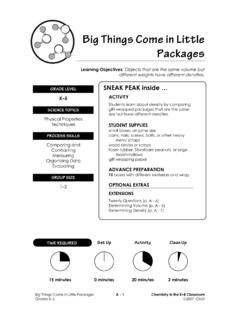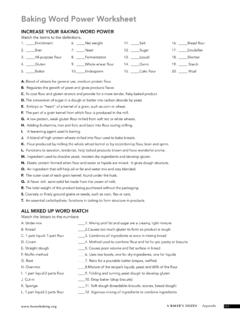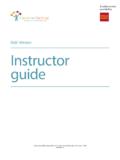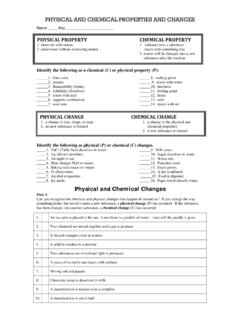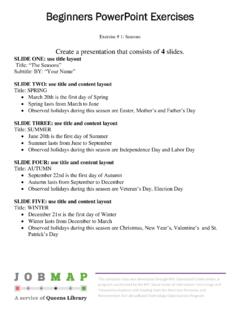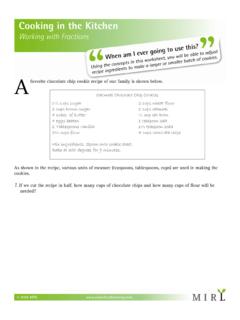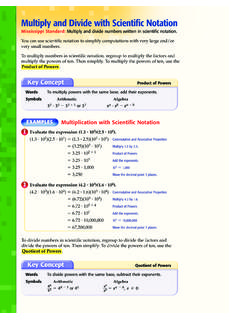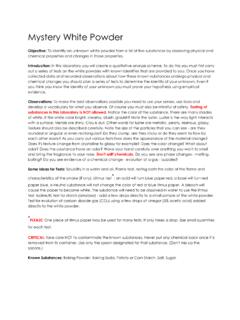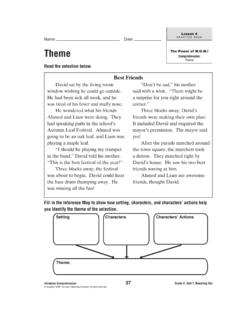Transcription of Reaction: Yes or No? - OMSI
1 Reaction: yes or no ? Learning Objectives: Students will list and identify three characteristics of chemical reactions . GRADE LEVEL SNEAK PEAK inside . 3 8 ACTIVITY. Students mix household materials and SCIENCE TOPICS observe color changes, fizzing, and heat. Solutions and Mixtures STUDENT SUPPLIES. Chemical reactions see next page for more supplies PROCESS SKILLS turmeric powder, rubbing alcohol Describing and Defining calcium chloride (from hardware stores). baking soda Measuring sealing plastic bags, etc . Explaining ADVANCE PREPARATION.
2 GROUP SIZE see next page for more details 1 3 Dilute alcohol with water Set out plastic cups, etc . OPTIONAL EXTRAS. If available, goggles are DEMONSTRATION. recommended for this activity. Acid Base Indicators (p. B - 40). Gas Production (p. B - 41). EXTENSIONS. Test Turmeric Indicator (p. B - 46). De-Icer Product Investigation (p. B - 47). TIME REQUIRED. Advance Preparation Set Up Activity Clean Up 15 minutes 5 minutes 20 minutes 5 minutes Reaction: yes or no ? B 37 Chemistry in the K 8 Classroom Grades 3 8 2007, OMSI. SUPPLIES. Item Amount Needed sealing plastic bag, ( , ZiplocTM) pint or sandwich size 1 per group *see Notes and Hints in Advanced Preparation plastic spoons 3 per group turmeric 1 teaspoon per group baking soda cup per group calcium chloride (available in hardware stores) cup per group isopropyl alcohol, 70% (rubbing alcohol) or 90% < cup per group plastic cups, 8 oz.
3 3 per group For Extension or Demonstration supplies, see the corresponding section. ADVANCE PREPARATION. Supplies Preparation Dilute isopropyl alcohol solution: Dilute 70% or 90% rubbing alcohol to make a 30 35% solution: For 70% isopropyl alcohol (rubbing alcohol), mix 1 part rubbing alcohol to 1 part water (this makes a 35% solution). For 90% isopropyl alcohol, mix 1 part isopropyl alcohol to 2 parts water (this makes a 30% solution). Fill pop-top squeeze bottles with about cup of alcohol. Label the bottles alcohol solution and write the concentration (30%.)
4 Or 35%). Make certain the pop-top is closed on all bottles so the alcohol does not evaporate. CAUTION: Isopropyl alcohol is flammable at 90% and 70%. concentrations. At a concentration of 30% 35%, its flammability is greatly reduced. Nevertheless, all open flames and sparks should always be kept away from these solutions. baking Soda: Fill plastic cups with cup of baking soda. Label the cups baking soda.. Turmeric Fill plastic cups with about 1 teaspoon of turmeric powder. Label the cups turmeric.. Reaction: yes or no ? B 38 Chemistry in the K 8 Classroom Grades 3 8 2007, OMSI.
5 Calcium Chloride: Calcium chloride (CaCl2) is available as a deicer or as a dehumidifier. deicer brands: ComboTherm and Road Runner. dehumidifier brands: Dry Z Air. other brands may work also look on the side panel and test other brands before using in class. Fill plastic cups with cup of calcium chloride. Label the cups calcium chloride.. CAUTION: Since calcium chloride absorbs moisture from the air, always store calcium chloride in an air-tight container. Notes and Hints Choose higher quality sealing plastic bags with slightly thicker plastic, because upon excessive handling some of the turmeric might diffuse through the plastic onto students' fingers.
6 SETUP. For each group 1 sealing plastic bag, pint or sandwich size 3 plastic spoons about 1 teaspoon turmeric in a plastic cup cup baking soda in a plastic cup cup calcium chloride in a plastic cup cup diluted alcohol solution in a pop-top squeeze bottle (keep top closed until ready to use). At a central location (or with the teacher). sponges and towels for clean up INTRODUCING THE ACTIVITY. Let the students In this activity, students will investigate a simple chemical reaction with speculate easily observable changes. before offering answers to any questions.
7 The The most common signs of chemical reactions include the following: answers at right appearance of a new gas, solid, or liquid are provided change in temperature for the teacher. appearance of light change in color change in pH. production of electricity Reaction: yes or no ? B 39 Chemistry in the K 8 Classroom Grades 3 8 2007, OMSI. Choose What do you think of when you hear the word chemistry ? questions that Explosions, foaming and bubbling potions, messy science, mixing things are appropriate for your together, etc. classroom.
8 Yes, chemistry is the study of matter (stuff) and how it reacts with other matter (stuff). When two things react together in a chemical way, they change each other, and the results can be quite dramatic ( , explosions, color changes, etc.). Can anyone list some specific examples of chemical reactions ? Student answers will vary depending on exposure to chemistry. Students might suggest fires, batteries, baking soda and vinegar, pH test kits for pools or hot tubs, bleaching hair, cooking food, rusting, gasoline in car engines, medical test strips used by family members (.)
9 For diabetes), etc. It's not critical that students correctly identify reactions at this point, but rather that they use what they know to make a list. Those all sound like chemical reactions , but how can we be sure? Let's just guess and make a list of what we think are signs of a chemical reaction using these examples. Some will say things explode or change color. Others might point out that heat is involved. You might ask students to list some real life examples of chemical reactions . Students can come up with their own list of signs of a chemical reaction and test it against the reaction in this experiment.
10 In this experiment, students will perform and analyze a real chemical reaction. TEACHER DEMONSTRATION. Acid Base Indicators This demonstration shows how the turmeric changes color in acids and bases. Because it changes color in different solutions, turmeric is an indicator for acids and bases. Supplies 2 clear plastic cups, 8 oz. or larger 30% or 35% alcohol solution from the activity turmeric powder 1 tablespoon vinegar 1 teaspoon baking soda Demonstration Add about cup alcohol solution to each cup. Add a pinch of turmeric powder to each cup and stir until it dissolves.



